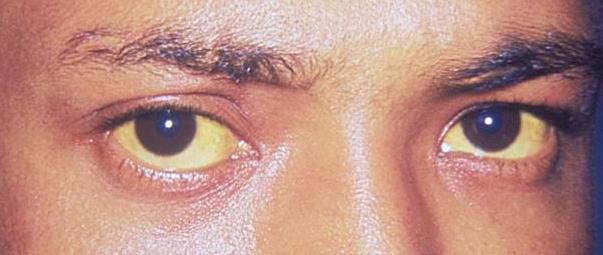Playlist
Show Playlist
Hide Playlist
Biochemistry of Bilirubin: Biliverdin Reductase
-
Slides Bilirubin Biochemistry.pdf
-
Reference List Biochemistry.pdf
-
Download Lecture Overview
00:01 Biliverdin reductase turns out to be one of the most diverse and amazing proteins in the entire body. 00:09 The number of things that it's involved in is astonishing. 00:13 Biliverdin reductase doesn't just catalyze the reaction that I've shown you to convert biliverdin into bilirubin. 00:19 But it also is a serine-threonine-tyrosine kinase. 00:23 Meaning, it is able to add phosphates onto all three of those amino acids. 00:28 And we've seen that kinases like this are very important in the signaling process. 00:33 So not only as biliverdin. 00:35 Reductase is important in the metabolism of bilirubin, but it's also potentially important as a signaling component. 00:46 In addition to that, biliverdin reductase affects insulin signaling. 00:50 Insulin signaling we have seen as important for managing the concentration of glucose in the bloodstream. 00:56 Biliverdin reductase, in addition, may block the movement of glucose into the cell. 01:01 This was something insulin is trying to stimulate in the first place. 01:05 Biliverdin reductase may play a role, therefore, in insulin resistance. 01:08 Insulin resistance happens when cells no longer are able to respond to insulin, and as a consequence, don’t take up glucose. 01:17 So this could be a very important player in that process. 01:21 Biliverdin has a leucine zipper domain. 01:24 Now you remember from other talks in this series that leucine zippers are very important both for protein, protein interactions and also for protein DNA interactions as occurs with transcription factors. 01:37 Biliverdin reductase therefore may act as a transcription factor. 01:41 And finally, biliverdin reductase may control cyclic AMP-related genes as it's seen in signaling pathways such as the beta adrenergic receptor. 01:51 This, as I said, is one of the most interesting proteins that's found in cells. 01:57 Now the biochemistry of bilirubin is important consideration for other things besides the reactive oxygen species that I've described. 02:05 Bilirubin is not very soluble in the aqueous environment of our cells. 02:11 So the reaction that I'm showing next here is to facilitate the solubility of bilirubin or a bilirubin component in water. 02:20 This involves the addition of glucuronic acid as you can see on the screen to bilirubin. 02:26 Glucuronic acid is a very water soluble molecule so it's attachment to bilirubin to make bilirubin diglucuronide facilitates bilirubins dissolving in water. 02:38 This reaction is called a conjugation and the conjugation of the bilirubin with the diglucuronide enables bilirubin now to be dissolved. 02:48 We see in the process that two waters are split out to make that. 02:52 And the product, as I said, diglucuronide is water soluble. 02:55 You can see the reaction, the starting material shown in the green square on the left that becomes the green circled portion or the green outlined portion on the right. 03:05 Using this, you can clearly see the addition of where the glucuronic acids occurs. 03:11 The endo reaction that's happening here, the precursor is known as UDP-glucuronic acid. 03:15 UDP is simply a carrier. 03:17 It is an activated intermediate that facilitates the donation of the glucuronic acid to the bilirubin as we see here. 03:24 The products or the reaction of course being two UDP molecules shown in the lower right. 03:30 The reaction here is catalyzed by the enzyme glucuronyltransferase. 03:35 Now as I said before, this conjugation creates a soluble form of bilirubin. 03:40 We call that conjugated form because it's conjugated to glucuronic acid and it dissolves in water. 03:46 This allows bilirubin to be easily eliminated through the bile and the feces or via the urine. 03:54 Bile of course is an aqueous environment. 03:57 The insoluble form of bilirubin is called the unconjugated form because it has no glucuronic acid attach to it. 04:04 It's the glucuronic acid that's making bilirubin becomes soluble. 04:09 This form of bilirubin can circulate in the bloodstream fairly readily attached to or bound to the protein known as albumin. 04:18 Now one of the problems that happens with this system is that bilirubin in this way is not filtered by the kidneys. 04:25 It doesn’t get eliminated and can ultimately result in the formation of the disease known as jaundice.
About the Lecture
The lecture Biochemistry of Bilirubin: Biliverdin Reductase by Kevin Ahern, PhD is from the course Amino Acid Metabolism. It contains the following chapters:
- Biliverdin Reductase
- Biochemistry of Bilirubin
Included Quiz Questions
Which of the following is true regarding biliverdin reductase?
- It is a serine-threonine-tyrosine kinase
- Its only function is to convert biliverdin to bilirubin.
- It plays a role in glucose movement in the body.
- It acts as a protease.
- It contains a threonine zipper.
Which of the following is true regarding the process of solubilization of bilirubin?
- It is required for it to be carried in the bile
- It involves the oxidation of bilirubin
- It involves the attachment of glucose to bilirubin
- It involves the reduction of bilirubin
- It involves the reduction of glucose
Customer reviews
5,0 of 5 stars
| 5 Stars |
|
5 |
| 4 Stars |
|
0 |
| 3 Stars |
|
0 |
| 2 Stars |
|
0 |
| 1 Star |
|
0 |






